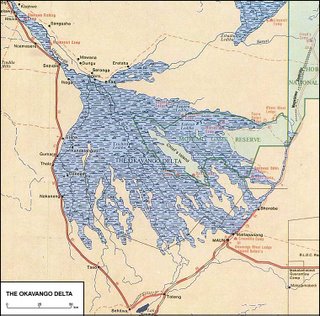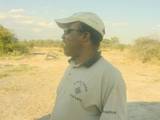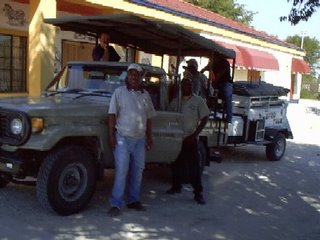Wonderful safari experiences in and around the Okavango Delta, Botswana. We try to share some aspects of the safari on our blog - a glimpse of what can be seen and done and heard in Moremi Game Reserve.
Friday, December 29, 2006
Afro Trek Safari - Safety
Whether you are staying at a lodge in the Okavango Delta or on mobile safari with Afro Trek Safari, safety is always concern number 1. Everyone has to realize that when you are on safari in the game reserves, you really are inside the zoo.
The pre-trip briefing, by your professional guide, is extremely important. It is your responsibility to understand and closely follow the safety guidelines. Make sure your fellow travellers understand the guidelines. Make sure your safari of a liftime is memorable for all the right reasons.
Your guide wants to get you as close to the big game as possible, in a safe manner. 99.9% of safaris run smoothly. Make sure you are not that 1 in a 1000.
Wednesday, December 20, 2006
Safari Safety - Introduction
After a day on safari exploring for big game and a great dinner in the bush, it is not unusual to sit up for awhile around the campfire. Often, the guides and guests share some great stories. Often the stories are about near accidents or narrow escapes. The themes often come back to safety. Some stories may be fanciful - many are not.
1. Bending over the side of a boat to free a fishing line as a crocodile jumps from a nearby bank and passes just over the startled person…
2. Escape by jumping over a log to get away from a charging hippo…
3. When a lion attacks, keep staring the lion straight in the eyes – it will stop. Your heart may also stop, but that is another story.
4. A guest video taping his own death, walking toward a buffalo herd…
5. Last but not least – hyenas. Often they are around camps at night. Their yup – yup sound is distinctive and yup, they can be very dangerous. Follow you guides advice about staying inside your zipped-up tent.
Saturday, December 16, 2006
Thursday, December 14, 2006
Afro Trek Flexibility
The annual rains are only just beginning in Northern Botswana. Trip plans for December to February will have to be flexible, with possible adjustments because of weather conditions. Not to worry, campers are a hardy group and the rain showers are often short and the skies exceptionally beautiful.
Remember, on the edge of the Kalahari Desert – life is all about water.
Monday, December 11, 2006
Botswana"s Best Books
There are two books of note in the right hand column of this page. If you have a friend or family member who likes stories about safaris or Botswana - consider these books.
Horn of the Hunter was written over 50 years ago and over 2,000 copies are still being printed yearly. It is a classic of the safari genre and highlights some of the early safaris by Maun's own Harry Selby.
Culture and Customs of Botswana is the other extreme. The book launch was just last week. Hopefully, 50 years from now it will still be in-print. Ideal for anyone planning a trip to Botswana in the New Year of for that special someone who has already visited and would like to learn more. Phenyo Thebe is currently working on his second book. For more of a description of the content click on Maun Blog.
Monday, December 04, 2006
Les Francaises on Safari - Le Professor

Excursion à Moremi
Un Game drive est toujours plein de surprises. Ce fut le cas. Départ très matinal : 6h
Nous sommes 16, il faut donc 2 4x4. Sur les banquettes nous gelons pendant le trajet que durera 2h jusqu’à la première entée. Petite pause d’une ½ h avec café et biscuits. Déjà quelques observations de gazelles et girafes aussi que d’oiseaux. L’excursion commence vraiment après la 2 eme entrée quand les plans d’eau apparaissent. La piste est plus étroite et plus route.
Observations réalisées :
1) Mammifères :
Girafes +de 20, Eléphants + de 100, Singes verts 10, Hippopotames 20, Gazelles et antilopes +200, Cobe défassa, Cobées rouges, Steenboks, Impalas en grand nombre, 2 lions au repas ainsi qu’une lionne
2) Oiseaux :
2 cormorans africains, 3 hérons cendrés, 1 aigrette ordoisée, 2 aigrettes ….., 3 ombrettes, 2 tantales, 1 cigogne blanche, 5 lois sacrés, 10 oies d’Egypte, 3 oies de Gambie, 2 aigles pecheurs, 1 aigle bateleur, 150 francolins à bec rouge, 30 pintades, 1 grue conanculee, 1 outarde, 25 jacanas, 40 vanneaux armés, 100 tourterelles du Cap et à colliées, 5 tomeras ……., 10 grepeurs en …., 5 rolliers à longs brins, 80 calaas à bec rouge, 2 hiromdeles, 1 gonolek rouge et noir, 50 …….. Flèches, Vols de tisserins travailleurs à bec rouge, 30 étourneaux métalliques, 10 étourneaux d’Alexandre, 30 fraque-boeufs, 5 corbeaux, quelques coucon et 1 vanran
Le pique-nique est délicieux : (salade, poulet sandwiches), jus de mangue ….Fruits ( banane poires). Le retour commence à 15h30 après observation finale de lions. Poussiéreux nous rentrons vers 18h45 plein d’émerveillements.
Monday, November 20, 2006
Maun Safari Flashback
I received an email over the weekend from Hugh Kelly. He is thinking about bringing some family members to Maun and taking them on safari. It was fun to think back to the trip we did 6 months ago. Along with his reflections on our safari, Kelly also provided a more complete version of his pelican ditty:
'Regarding pelicans - funny old birds, as discussed around the campfire
after a few shots of Bells.'
" A funny old bird is the Pelican
His beak can hold more than his belly can
He fills up his beak
With enough food for a week
But I'm sure I don't know how the hell he can"
Thursday, November 09, 2006
San Diego Reader - Breaking News
For stories about Botswana, the Okavango Delta and Moremi Game Reserve click and go to the San Diego Reader. This weeks story is the second of five stories to be published during the month of November. You can read the first short story by clicking 'previous blogs' after the end of this story.
Diva Barbarella was gracious enough to contact Delta Dave about two months ago, requesting Botswana stories for her newspaper. It has been fun writing the stories and has helped me focus on what I really like about Botswana. Hope the readers of the Afro Trek blog enjoy them.
Saturday, October 28, 2006
Wildlife Magic On Safari, Botswana Part 2

Sunday, October 22, 2006
Wildlife Magic on Safari, Botswana
 Trevor Peake Enjoys A Trip To Botswana, Part 1
Trevor Peake Enjoys A Trip To Botswana, Part 1From the pages of the Liverpool, Daily Post in Trevors own words -
"Hundreds of buffalo leisurely grazing their way across the savannah as dusk fell will be my abiding memory of a few days in the Moremi Game Reserve, part of the vast Okavango Delta, in northern Botswana."
"Our guide Shylock spotted what we thought was just a small group, but after expertly circling round through the bush he found the front of what turned out to be a vast herd of Cape Buffalo. We could only watch in wonder for over half an hour as they strolled by, the odd magnificent bull giving us the once over as we observed them from the safety of our safari truck 30 yards away."
"An hour earlier, we had been even closer to a male lion, which showed the scars of a recent skirmish. Such splendid sights are what makes a safari the magical experience it is.:
Tuesday, October 17, 2006
Afro Trek Country, Botswana
 I cannot remember where the map comes from, but it's a good one. It hightlights Moremi Game Reserve and a number of the camps and lodges around the Okavango Delta. Afro Trek does regular trips to the Tsodilo Hills in the north west all the way over to Chobe National Park in the east. Moremi Game Reserve remains our most popular destination area.
I cannot remember where the map comes from, but it's a good one. It hightlights Moremi Game Reserve and a number of the camps and lodges around the Okavango Delta. Afro Trek does regular trips to the Tsodilo Hills in the north west all the way over to Chobe National Park in the east. Moremi Game Reserve remains our most popular destination area.Monday, September 25, 2006
Maun Safari Choices

Wednesday, August 30, 2006
Botswana National Bird?

Sunday, August 20, 2006
Maun and 'The Gates of Eden'

The current is pushing downstream and the flood peak could still be a month away. Going up the Bore to the buffalo fence is about 12 km. You see domestic animals, birds and a variety of farming and garden plots along the river. The buffalo fence is the boundary of the Moremi Wildlife Reserve. Here, everything changes.
Now you enter the 'Gates of Eden' or as close as I am going to get in this lifetime. You don't go too many kilometres before you see wildlife. You feel like you are on a wet safari - cape buffalo, giraffe and elephants are not uncommon. The narrow river channel arcs and bends in front of you. The panorama is wonderful.
Thursday, August 17, 2006
In Search of Baobab Beauties

We all know why visitors come to Botswana - lions, elephants. hippos, birds, desert, culture, friends... What about trees? Less than two weeks ago, seven of us camped overnight in the Gwebe Hills, about 180km from Maun. Along with climbing two of the hills to enjoy the views, seeing eight kudu spring across an open plain and keeping intouch with the group, I keep looking at these amazing Baobabs.
There are more famous places in Botswana for viewing baobabs, like Kubu Island in the Makadikadi Pans. For pure numbers, the Gwebe Hills are hard to beat. My guess, from one visit, is there are more than a 1,000. All configurations are there - the lone baobab, the entertwined couple and the family groupings.
Hard to forget the old baobab once you see one. The kind of look upsidedown, with a bad hair day. The age of an individual tree is a good discussion for around the campfire, after dinner - 1,000 years sounds like a minimum for a big baobab. They are so fat because they store water for the periodic droughts that occur.
At the end of the day, for me, the baobab is mystical - they just give me a special feeling and sense of reverence. Of course I feel that way about all big trees and also like the local jackelberry tree. Once it takes more than 4-5 people to stretch around a tree, your into something special.
Thursday, July 27, 2006
A Bird's Eye View - Part 2
 Visitors love to take mokoro trips and have the opportunity to silently move through the Okavango Delta and see the wide range of wildlife available. The traditional dug-out canoe, or 'Mokoro' was originally introduced into the Okavango Delta by the Bayei tribe who moved into the region, from the Zambezi River area, after the 1750's. The presence of the tsetse fly meant that pastoralism was not possible and instead they relied on hunting and fishing for subsistence.
Visitors love to take mokoro trips and have the opportunity to silently move through the Okavango Delta and see the wide range of wildlife available. The traditional dug-out canoe, or 'Mokoro' was originally introduced into the Okavango Delta by the Bayei tribe who moved into the region, from the Zambezi River area, after the 1750's. The presence of the tsetse fly meant that pastoralism was not possible and instead they relied on hunting and fishing for subsistence.Trees that were favoured, by the Bayei people, for the construction of mekoro were the Mukwa, Jackal Berry and Sausage Trees. A tree might take well over a century to attain Mokore size - but the lifespan of the Mokoro would typically only be about 5 to 8 years.
In the interests of conservation and the protection of the trees and ecology of the Delta, most of the mekoros used for visitors today are made of fiberglass reinforced plastic - the shape has stayed the same. The pole or 'nashi' that is often used to push the Mokoro is the Mogonono tree. When you start your Mokoro trip you may well hear expressions of 'Tsamaya Sentle' - Travel of Go Well. Your Polers will give you more stories and cultural background during your breaks from game spotting.
Thursday, June 22, 2006
Bird Watching With Kelly.
 Shylock starting out on a mobile safari.
Shylock starting out on a mobile safari.We rise and shine just before 6 am and down some coffee, toast, jam and boilded eggs. With a thermos filled with boiling water for our mid morning tea, we head off in search of game. Shylook takes us around the edges of flood plains that are filling up with the flood water from Angola. We move off, down stream from the Kwai River Bridge in the Moremi Wildlife Reserve.
Along the way we view some impala, kudu and baboons. Two elephants are spotted foraging for their breakfast. Fresh lion tracks get us excited, but prove elusive. Vehicles are not permitted off existing paths.
The highlight of the morning is stopping near a 30 metre round pool of water, left over from our recent rainy season. The menagerie of birds co-existing peacefully during their morning feeding is impressive. Black Crake, Marabou Storks and Grey Herons mix with Sacred Ibis, African Jacana and 2 Great White Pelicans.
Kelly, one of our fellow travellers from Australia and a bird lover, spots 2 Wattled Cranes flying over our vehicle. After some discussion about their endangered species status and recent migratory bird counting activities, Kelly starts to hum to himself and soon recites bits and pieces of something like: "A funny old bird is the Pelican; His beak holds more food than his belican..."
Before we return to camp for midday feed and some rest, there is one more treat. The Lilac-breasted Roller - Botswana's National Bird is spotted. With good natured talk of our luck and spotting skills, we arrive back at basecamp.
Sunday, May 28, 2006
Gliding Through Nature - A Bird's Eye View.
Afro Trek partners with Mokoro Trails, a local community trust - delivering and picking up visitors. Mokoro trips are an eco-tourism activity that gives the visitor a snapshot view of a traditional mode of transport. Motswanna have for centiries been navigating for the maze of channels that is the Okavango Delta.
Along with birds you are likely to see various antelope, elephant, buffalo, zebra, giraffe and lion. Doing the Mokoro Trails and participating in this type of eco-tourism make a positive impact to the polers and their communities, without compromising our environment. Enjoy one of the largest inland deltas in the world - the feeling can be overwhelming. When you get home - your photos and videos will help you regain your composure.
blog, culture, travel, photos
Saturday, May 06, 2006
When Visitors are Fulfilled
Shylock really likes people who come to Africa to see the differences from what they know back home. He believes "indigenous guides are best suited to help them explore the bush and the culture of Botswana." Shylock knows and loves Botswana. The same applies to being a Safari Guide.
Often he has to balance the different needs of guests interested in birds or big game. "Ideally, we move when customers are fulfilled with what they are watching." Some time each day needs to be spent reviewing what was seen and done.
Shylock Raborokgwe gets "excited when I spot a special animal, like a leopard, that a guest has never seen before." Knowing the particular habitat that supports an animal or bird is the skill he uses to find the game.
Sunday, April 23, 2006
Professional Safari Guide - Viewpoint
Part 1:
“Knowing the beauty of your own country.” – Shylock Raborokgwe
Over 20 years as a Professional Guide has taken Shylock to all destination areas in Botswana. He’s been to Moremi and Chobe Game Reserves. He likes to combine trips to the Central Kalahari Game Reserve and the Okavango Delta – “let guests see how dry the desert is, no water, no shower, dust; then go the Delta and travel for a few days with water everywhere. The contrast is the Botswana experience! The two ecosystems are terribly different. People coming to Botswana want to see the diferences”
Shylock has done trips to Nxai Pan, Linyanti, Kutse Game Reserve, Drotsky’s Caves and Tsodilo Hills. For him, “The Tsodilo Hills are a ‘different ballgame’ – you don’t see the obvious, your away from everthing and the paintings are something else. ”
In Part 2, we will find out what Shylock considers ‘a perfect trip.’
Sunday, April 16, 2006
Harrys Botswana Experience


Visit Harrys Botswana Journal and see Ngamiland through the eyes of a 10 year old explorer. His original hand written journal is provided to give that 'on the road' feeling.
The relaxed leopard was one of the highlights of the morning game drive. After 10 minutes with the leopard it was time for Harry and the rest of the group to have breakfast and talk about the mornings sighting.